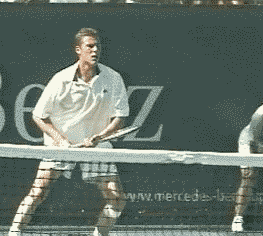<% ns_puts [mkm_getnavbar] %>
Building the Modern Forehand
Part 2: The BackSwing
by John Yandell
| page 2 |
Sideways Movement
The movement from side to side in the backswing is much less than the movement upwards or backwards. This makes it even harder to follow.
|
|
It’s also related to whether or not the player closes the racquet face, and,
if so, how much.
Typically, the less the player closes the face, the more he moves the racquet
to his right at the start of the backswing. And the more he moves it to the
right at the start of the backswing, the more he tends to move it back to
the left as well.
Conversely, the more the player closes the face, the less he tends to move
his racquet to the right at the start of the motion, and the less movement
back to the left thereafter.
The only exception appears to be Marat Safin (more on that below).
Haas keeps his racquet literally on edge, and moves his racquet head the furthest to the right at the start of his backswing, around two feet as the motion starts upward. He then moves the racquet back to the left to get to top of the motion, and continues this motion to his left as he starts down.
Roddick and Pete on the other hand have minimal movement of the racquet head
to the right, and minimal movement back the other way.
The rest of the
players are in between the extremes, with some motion to the right and some
motion back to their left.
Sideways movement in the backswing: from least to most




| 1. Roddick | 2. Pete | 3. Guga | 4. Hewitt |


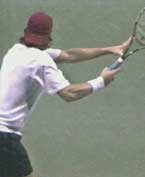
| 5. Safin | 6. Agassi | 7. Haas |
Agassi and Hewitt close the face partially, and still have substantial
sideways motion, but noticeably less than Haas. Safin is the exception,
closing the face as far as Guga and Roddick, but with about the same
sideways movement as Agassi and Hewitt.
Pete Sampras turns the face all the way down and has less sideways
movement than possibly anyone but Roddick. But in looking at the sideways
component, we once again have to distinguish between how far the hand moves
and where the hand and the racquet point.
Although Pete has little sideways hand movement
his racquet tip actually reaches farther to the right because he is also
pointing his hand to the side.
This is the same for Roddick at the bottom of his backswing (see below). As
his racquet drops, it will end up pointing farther than anyone but Pete.
It's just another one of the complex differences among the players.
|
|
Again all these factors vary independently of grip, so there seems to be no simple explanation of the differences between the players in our first three factors.
Racquet Rotation
This brings us to the fourth issue, how much the racquet rotates or
“closes” during the backswing.
When the players “close” the racquet face, they are actually rotating the
racquet face downward or counterclockwise, from their right to their left.
Some players, like Agassi, close the face only partially. Other players like
Pete and Hewitt go further, rotating the face until it is pointing straight
down at the court. This is typically considered fully “closed.”
But some players go further than the so-called closed position. Safin, Guga
and Roddick all continue turning the face over in the counterclockwise
direction another 90 degrees, until the racquet edge is again straight up
and down. They literally turn the racquet face upside down.
Even on the high speed video, this turning motion is hard to see, because as it is happening, the players are also moving the racquet head upward. But you can follow it if you focus on the edge of the frame.
Watch the racquet continue to turn past what we think of as the totally closed position. As the racquet gets to the top of the backswing, the left edge of the frame is pointing more or less at the net.
Does this extra rotation affect the shape of the backswing? The answer is it
can reduce the amount of movement in the left to right dimension, although
this isn’t true for all three players.
Safin turns the racquet over all the way, but he also moves it to the right
on the way up, similar to Agassi. This means he also moves the racquet
back to his left to reach the top of his motion. He also continues this
motion to his left as he starts the racquet down.
But Guga and Roddick also turn the racquet face all the way over, and they have much less sideways movement in both directions. They also take the racquet upward on a much straighter line than Safin.
|
|
Guga appears to move only a few inches to the right on the way up, and then back to his left about the same amount, although there may be more sideways movement when he is on the run.
Roddick has almost no movement in the side to side dimension. He keeps the racquet in very close to his torso on the way up, and then has only minimal if any movement to his left on the way down.
It appears these players are trading off one kind of movement for another, rotating the racquet more in order to reduce the side to side movement. But is that really an advantage? Another good question with no easy or apparent answer.
Closure on the Way Down
Which brings us to factor number five: what happens to the racquet face on the way down?
Some of the top players close the face almost completely, others virtually
not at all.
Haas and Roddick for example sometimes point the racquet face almost
completely down at the court. Safin is also close to this position. Hewitt
closes the face only slightly less.
Agassi closes the racquet somewhat on the way down, maybe slightly more than
at the top of his motion, but much less than these players.
On the other hand Pete and Guga don’t close the racquet face much if at all
on the way down. At the top of the motion they both have the racquet almost
straight up or on edge, and they keep the angle the same, or even square the
racquet face slightly more as they start down.
Closing the racquet face on the way down: from least to most


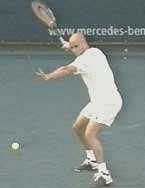

| 1. Pete | 2. Guga | 3. Agassi | 4. Hewitt |



| 5. Safin | 6. Roddick | 7. Haas |
So you have Pete with the least extreme grip and Guga with one of the more
extreme grips both keeping the racquet on edge.
Meanwhile, Safin, Roddick and Haas are at the other extreme with the face
fully closed or close to it, with Hewitt and Agassi in the middle. Once
again, the grip style proves a non-factor in deciphering what is happening.
Some coaches and players advocate the closed face position as the racquet
moves downward in the backswing, believing it relates to the ability to
generate topspin and/or racquet head speed.
But is there really any advantage? That seems dubious. In fact, I think the
footage tends to support the opposite conclusion, that closing the face that
far is a potential liability.
For one thing the closed face isn’t a commonality. Two of the players with
the biggest forehand in tennis history, Agassi and Sampras keep the racquet
close to on edge. It’s not a requirement for heavy topspin either, as Guga’s
motion shows.
To generate pace and spin the arm has to reach the hitting arm position.
Closing the face all the way appears to make the motion to reach the hitting
arm position longer and also more complex. This is related to our final
backswing element, the timing to reach the bottom of the backswing, as we
will see.
Timing to Hitting Arm Position
We saw in the first article how all top players reach the hitting arm
position as the racquet starts forward to the ball. But some reach it much
earlier than others.
Again there doesn’t seem to be a relationship between the timing and the
grip style.
Reaching the hitting arm position: from earliest to latest


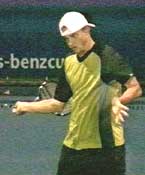
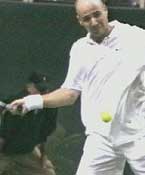
| 1. Pete | 2. Guga | 3. Roddick | 4. Agassi |
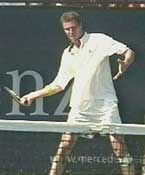


| 5. Safin | 6. Hewitt | 7. Haas |
No top pro reaches the bottom of the backswing with the face still fully
closed. At some point in the downward motion, all the players begin to
square the racquet face, tuck the elbow in toward the torso, and find the
laid back wrist position.
Most of the players reach the full hitting arm position about 1/10 of a
second before the hit, or even a little less, though it can vary somewhat
from ball to ball.
Guga and Sampras both have the racquet more on edge on the way down, and
they clearly get to this position much sooner in the motion, around 2/10s of
a second before the hit.
Note that we are saying that 1/10 of a second is a “large” difference! It
just goes to show you how fast things really happen in pro tennis. It also
raises an interesting point about the efficiency of the closed face racquet
position on the way down.
The players who close the racquet face the most on the way down, for
example, Haas and Roddick need much more motion to reach the bottom of the
backswing.
They have to rotate the arm and the palm of his hand over about 90 degrees
to get the racquet on edge, as well bend the arm at the elbow and lay the
wrist back. As they do this from the extreme closed face position, it causes
the racquet head to swing behind them and to the right in a curving motion.
This all has to happen in a few milliseconds before the start of the
foreswing. It seems much more complicated, and it definitely takes longer
than the simple dropping motion Agassi uses with the racquet virtually on
edge.
Yes, Haas and Roddick definitely get to the hitting arm position on time, that is at the start of the foreswing, or up to a 1/10 of a second before.
|
|
Who knows, maybe there is even some advantage for Haas and Roddick in terms of racquet head acceleration. Or maybe it’s irrelevant. We don’t really know. (See more on measuring these factors through quantitative analysis below.)
But one thing for sure, any potential advantage is more than wiped out if
the player doesn’t deliver the racquet head to the hitting arm position on
time.
I actually saw this exact problem when an avid 4.5 men’s player came to San
Francisco recently to do a video analysis of his strokes. He was tortured by
the lack of power and consistency on his forehand, which he felt should be
his best shot.
He had a fairly extreme semi-western grip and had been taught the extreme
closed face position on his backswing. When we videoed his motion, however,
we saw that he kept the face closed well past the pro position, all the way
to the bottom of the backswing.
He never moved to the hitting arm position. In fact his racquet face was
still completely closed well into the start of the foreswing. This
dramatically reduced his ability to accelerate the racquet, since the palm
of his hand was pointing downward instead of forward in the direction of the
swing.
We looked at his motion on video and compared it to some pro players,
particularly Agassi. He responded well and began working on closing the face
less and on setting up the hitting arm position earlier.
In less than an hour the difference was amazing—the ball was coming off his
racquet with a lot more zip and he was able to control the consistency of
the swing much better from ball to ball.
Again we find something that may work for a top player is not always the
best model for the rest of us.
Backswing Patterns
So now that we’ve dissected all the factors and taken the top players’ backswings apart, let’s put the pieces back together. Let’s take a look at their motions from start to finish and see how everything fits together, and try to summarize what each player does. Then at the end, we’ll try to draw some limited conclusions about what it might all mean.
|
|
Tommy Haas
Hass has one of the most extreme grips. But, as we saw, his backswing is
among the most compact of the players we have examined, at least in terms of
hand position and racquet position.
He starts with the racquet basically on edge in the ready position. Alone
among the players we are looking at, he keeps the racquet on edge and
doesn’t close the face at the start of the upward motion.
Because of this, his backswing has the most sideways movement to his right.
He has a very traditional looking loop, closing the face only slightly at
the top, with the tip of his racquet is pointing at an angle upward and
slightly behind him.
On the way down, his motion becomes more extreme. First, he moves his hand
fairly sharply back from his right to his left, bringing the elbow into the
side of his body. At the same time, he closes the racquet face almost
completely, sometimes actually pointing it all the way face down to the
court.
To get to the hitting arm position, he rotates his hitting arm and the tip
of the racquet upward from this closed position, as we have seen. He arrives
in this position with his elbow in and wrist land back just at the start of
the forward swing, or a fraction of a second before.
|
|
Gustavo Kuerten
Unlike Haas, Guga closes the face of the racquet almost completely at the
start of the swing, and continues to turn the racquet over as he starts his
upward motion, rotating the racquet face another 90 degrees. His upward
motion is more direct with far less movement to the side than most players.
At the top of the backswing, his hand is above shoulder level and the tip of
his racquet points almost straight up at the sky. Interestingly, even though
Guga’s hand position is higher than Haas’s, his elbow position is actually
much lower, pointing downward at an angle toward his torso.
From the top of the backswing, Guga closes the racquet face at most only
slightly, far less than Haas. For this reason he moves into the hitting
arm position much sooner than most of the other players, well before the
bottom of the backswing.
|
|
Lleyton Hewitt
Hewitt is less closed at the start of the motion than Kuerten, but on the
way up, he turns the racquet face almost all the way down. He keeps his arms
quite bent at this point, however, and doesn’t have much motion at all to
his right.
Unlike Guga or Roddick, however, he keeps his racquet close to the toros
without continuing to turn the face over.Instead, he opens it again somewhat
on the way up, so that it is only partially closed at the top.
On the way down, he closes the face again, much more than Guga, at times
almost as far as Haas. But the face stays closed more briefly than Tommy. He
turns his hand and racquet upward sooner as he moves toward the bottom of
the motion. Bu his arm stays somewhat straighten as he does this so that his
hand and elbow fall into the hitting arm position later than Guga and more
like Haas, just at the start of the foreswing or slightly before.
|
|
Marat Safin
Safin, as we have seen, is an interesting case. He starts with the face
partially closed, closes it almost completely as the backswing starts, then
continues to turn the racquet all the way over like Guga and Roddick.
But unlike them, he also moves his racquet and racquet hand to the right as
the motion starts, and then back to his left on his way to the top. This
motion back to his left continues on the way down as well.
Although he has a higher hand position than Guga at the top of his motion,
the tip of his racquet is lower. This is because it points the racquet
somewhat forward and to the side rather than straight up in the air.
Safin closes the face again on the way down, but usually not all the way. At
this point his elbow is somewhat bent and tucked in. Like Hass and Hewitt,
he finds the hitting arm position more or less at the last instant before
the motion starts forward.
|
|
Pete Sampras
We think of Pete Sampras as being a classical player, but his backswing
motion is probably as complex or more complex than any top pro.
Pete starts with the racquet on edge and pointing slightly to his left. As
the backswing starts, he raises his elbow and actually tilts the tip of the
racquet downward at least a foot.
As his elbow and hand continue to rise, he starts to close the face by
turning his palm downward toward the court, but he also turns his hand
outward toward the sideline. This points the tip of his racquet directly to
his right, reaching much further in that direction than any of the other
players. Despite the racquet tip position, however, his racquet hand is
still very close to his torso, closer than any player but Roddick.
As he starts the motion upward, Pete begins to open the racquet face. At the
top, the tip of the racquet is pointing almost straight up with the face only
slightly closed.
On the way down, Pete moves the racquet back slightly to his left. He also
squares the racquet face much faster than most players, so the
face is perpendicular to court halfway through the downward motion, or even
sooner. Because of this, he moves into the hitting arm position the soonest
of any player except Guga, getting there twice as fast as most other
players, well before the bottom of the backswing.
|
|
Andy Roddick
Roddick’s backswing probably has the most unusual shape, or at least the
most unfamiliar.
In the ready position, he has the racquet on edge, despite his extreme grip.
At the start of the motion, however, he partially closes the face. Then like
Guga and Safin he continues to turn his palm over until the racquet face is
upside down.
Since he starts with the racquet on edge, he rotates the racquet head
something close to 180 degrees, more total rotation than either Guga or
Safin, who both start with the racquet face at least partially closed.
As he is turning the racquet face over, Roddick is also raising it almost
straight up, so the racquet tip ends up pointing almost directly at his
opponent. The shaft of his racquet is actually parallel with the court at
this point in the motion.
From this position he raises the hand slightly further upwards, moves it
slightly backwards, and then starts downward. As noted, his downward motion
is in the straightest line of any player, with very little movement back to
his left.
On the way down he also closes the face dramatically, around the same amount
as Haas. Unlike Haas, as he starts to move downward, he also turns his
hand to the right. This causes the tip of the racquet to swing to his right
and point almost directly at the sideline. His hand position is the
closest to the torso, but his racquet position is the furthest to the right
of anyone but Pete.
Roddick then rotates his arm and racquet hand upward, tucks his elbow inward
and lays the wrist back the furthest of all our players in setting the
hitting arm position. This last phase of the motion is again similar to
Haas, happening just a fraction before the bottom of the backswing and the
start of the foreswing.
|
|
Andre Agassi
Agassi has the simplest and most internally consistent backswing. He starts
with the racquet more or less on edge, closes it slightly as he starts the
turn, and the racquet face stays pretty much at this same angle all the way
up. As he starts the loop, he moves his arm and racquet to the right, further
than most of the other players, but less than Haas.
At the top of the backswing, his racquet face is slightly closed, similar to
Hass. But unlike Tommy, the tip of the racquet is pointing slightly forward
and upward and also tilted slightly to the side.
As he starts down, Agassi moves his hand and racquet back to his left, but
far less than Hass or Roddick. As he does, he keeps the angle of the
racquet face quite constant, at about same angle as at the start of the
motion.
As he starts to get close to the hitting arm position, he usually squares
the face slightly more, until it is close to perpendicular. He drops
straight down into the hitting arm position just before the start of the
foreswing, a little sooner than some players, but not as quickly as Pete or
Guga.
To contact us, please email to: webmaster@tennisone.com TennisONE is a registered trademark of TennisONE and SportsWeb ONE; Copyright 1995. All rights reserved. |
|









